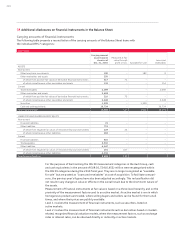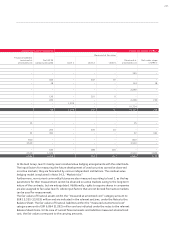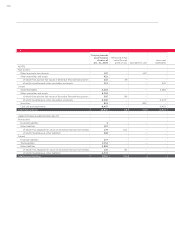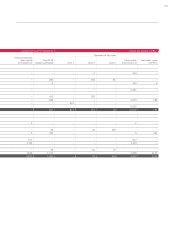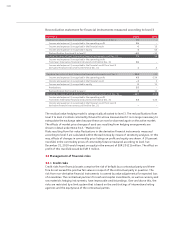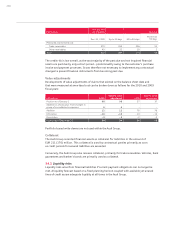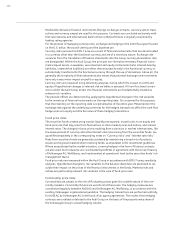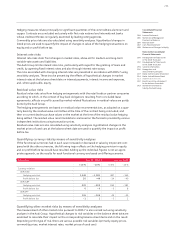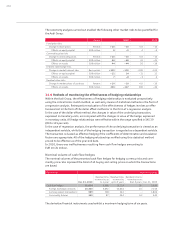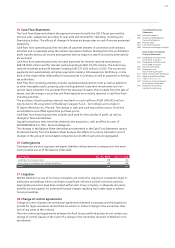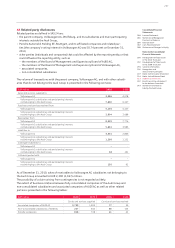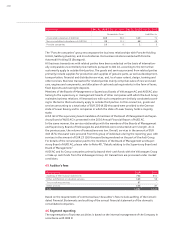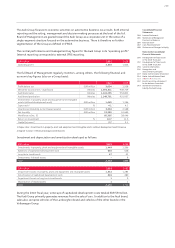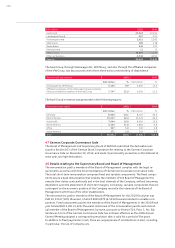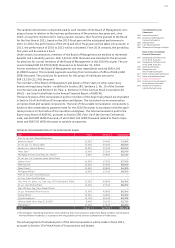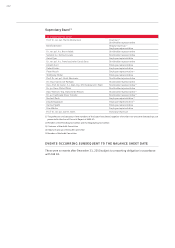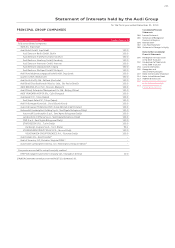Audi 2010 Annual Report Download - page 235
Download and view the complete annual report
Please find page 235 of the 2010 Audi annual report below. You can navigate through the pages in the report by either clicking on the pages listed below, or by using the keyword search tool below to find specific information within the annual report.
233
Consolidated Financial
Statements
184 Income Statement
185 Statement of Recognized
Income and Expense
186 Balance Sheet
187 Cash Flow Statement
188 Statement of Changes in Equity
Notes to the Consolidated
Financial Statements
190 Development of fixed assets
in the 2010 fiscal year
192 Development of fixed assets
in the 2009 fiscal year
194 General information
200 Recognition and
measurement principles
207 Notes to the Income Statement
214 Notes to the Balance Sheet
223 Additional disclosures
242 Events occurring subsequent
to the balance sheet date
243 Statement of Interests
held by the Audi Group
Hedging measures relate principally to significant quantities of the commodities aluminum and
copper. Contracts are concluded exclusively with first-rate national and international banks
whose creditworthiness is regularly examined by leading rating agencies.
Commodity price risks are also calculated using sensitivity analyses. Hypothetical changes in
listed prices are used to quantify the impact of changes in value of the hedging transactions on
equity and on profit before tax.
Interest rate risks
Interest rate risks stem from changes in market rates, above all for medium and long-term
variable-rate assets and liabilities.
The Audi Group limits interest rate risks, particularly with regard to the granting of loans and
credit, by agreeing fixed interest rates and also through interest rate swaps.
The risks associated with changing interest rates are presented in accordance with IFRS 7 using
sensitivity analyses. These involve presenting the effects of hypothetical changes in market
interest rates at the balance sheet date on interest payments, interest income and expenses,
and, where applicable, equity.
Residual value risks
Residual value risks arise from hedging arrangements with the retail trade or partner companies
according to which, in the context of buy-back obligations resulting from concluded lease
agreements, effects on profit caused by market-related fluctuations in residual values are partly
borne by the Audi Group.
The hedging arrangements are based on residual value recommendations, as adopted on a quar-
terly basis by the residual value committee at the time of the contract being concluded, and
then on current dealer purchase values on the market at the time of the residual value hedging
being settled. The residual value recommendations are based on the forecasts provided by various
independent institutions using transaction prices.
Residual value risks are also calculated using sensitivity analyses. Hypothetical changes in the
market prices of used cars at the balance sheet date are used to quantify the impact on profit
before tax.
Quantifying currency risks by means of sensitivity analyses
If the functional currencies had in each case increased or decreased in value by 10 percent com-
pared with the other currencies, the following major effects on the hedging provision in equity
and on profit before tax would have resulted. Adding up the individual figures is not an appro-
priate approach, as the results for each functional currency are based on differing scenarios.
EUR million Dec. 31, 2010 Dec. 31, 2009
+ 10 % – 10 %+ 10 % – 10 %
Currency relation
EUR/USD
Hedging provision 1,249 – 1,181 487 – 365
Profit before tax 20 – 49 – 24 – 40
EUR/GBP
Hedging provision 325 – 325 184 – 182
Profit before tax 0 – 0– 38
EUR/JPY
Hedging provision 126 – 126 49 – 49
Profit before tax – 1 1 – 22
Quantifying other market risks by means of sensitivity analyses
The measurement of other market risks pursuant to IFRS 7 is also carried out using sensitivity
analyses in the Audi Group. Hypothetical changes to risk variables on the balance sheet date are
examined to calculate their impact on the corresponding balance sheet items and on the result.
Depending on the type of risk, there are various possible risk variables (primarily equity prices,
commodity prices, market interest rates, market prices of used cars).



